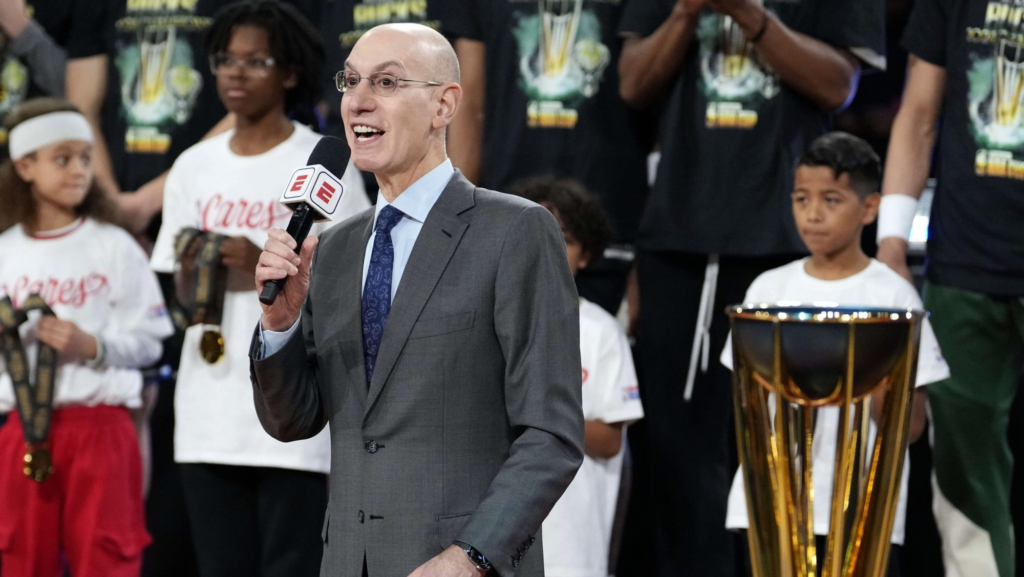
NBA TV ratings have been a hot topic for years, and recently, they’ve become an even bigger focal point. Commissioner Adam Silver has acknowledged the dip in viewership but insists the issue might not lie with the league’s product. While basketball remains one of the most dynamic and entertaining sports globally, several factors may contribute to these declining numbers. Let’s take a closer look at the situation and explore what might be behind the downward trend.
The Evolution of Sports Viewership in the Streaming Era
Television, as we knew it a decade ago, is no longer the primary platform for entertainment. Streaming services and on-demand viewing have disrupted traditional TV consumption habits, and sports broadcasting hasn’t been immune to this transformation. With platforms like Netflix, Hulu, and YouTube dominating screen time, fewer people tune into live broadcasts.
The NBA’s audience is a young and tech-savvy demographic that’s far more likely to stream games on their mobile devices or tablets than to watch them on cable. Even the league’s partnerships with streaming platforms like ESPN+ or NBA League Pass face competition from pirated streams. While the NBA has attempted to embrace digital trends, monetizing viewership on these platforms remains a complex challenge.
Moreover, the rise of social media has also affected how fans consume basketball. Many people opt to watch game highlights on Instagram, TikTok, or YouTube rather than sitting through an entire broadcast. This shift in behavior has led to fewer viewers tuning into live games, which directly impacts TV ratings.
Saturation of Sports Content
One potential explanation for declining NBA TV ratings could be the sheer saturation of sports content available today. With multiple leagues like the NFL, MLB, NHL, and MLS vying for attention, sports fans have more choices than ever. Throw in international leagues and competitions, and it’s easy to see how the landscape has become crowded.
This is especially true during certain parts of the NBA season when it competes with other major sporting events. For instance, NFL games dominate the sports calendar in the fall and early winter months, drawing significant attention away from the NBA’s early season matchups. Similarly, March Madness often overshadows regular-season NBA games in the spring.
Furthermore, niche sports like Formula 1, UFC, and esports have gained substantial traction, pulling viewership from traditional leagues like the NBA. With limited time and attention, fans often choose their favorite events over keeping up with a full 82-game NBA season.
Length of the NBA Season and Fan Fatigue
The NBA’s 82-game season can feel overwhelming, even for die-hard fans. With games almost every night and a long stretch between the opening tip-off in October and the Finals in June, many fans experience burnout. As a result, they might skip watching games until the playoffs, where the stakes are higher and the matchups more exciting.
Casual fans, in particular, are less inclined to follow regular-season games, especially those that don’t involve marquee teams or players. While the league has worked to create more compelling storylines and rivalries, maintaining consistent engagement over such a long season is a significant hurdle.
Additionally, some argue that load management—the practice of resting star players during regular-season games—has further dampened interest. Fans tuning in to watch their favorite stars might be disappointed to find them sitting out, reducing the appeal of live broadcasts.
Changing Viewing Habits of Younger Audiences
Younger audiences have grown up in a digital-first world, and their viewing habits reflect that. They’re more likely to consume bite-sized content, like highlights or clips, instead of committing to a full game broadcast. This shift poses a challenge for the NBA, as it needs to find ways to cater to this audience while maintaining traditional viewership.
Platforms like TikTok, Snapchat, and Instagram have become crucial for reaching younger fans, but these platforms aren’t designed to deliver the same advertising revenue as TV broadcasts. The NBA’s challenge lies in monetizing these new forms of engagement without alienating traditional audiences.
Another factor is that younger fans often support individual players rather than teams. This trend means that if their favorite player isn’t playing or has an off night, they might skip watching altogether. The league’s efforts to market its biggest stars have been successful in some ways but have also led to a more fragmented audience.
Competition from Non-Sports Entertainment
Sports aren’t just competing with other sports; they’re competing with everything else that demands our attention. From blockbuster movies and binge-worthy TV shows to video games and social media, there’s no shortage of entertainment options. The NBA TV ratings has to contend with this crowded landscape, where viewers have endless choices.
Video games like NBA 2K have become a significant part of basketball culture, but ironically, they might also pull fans away from live games. Gamers often spend hours playing virtual basketball instead of watching the real thing. Similarly, streaming platforms like Twitch and YouTube Gaming attract millions of viewers, further dividing audience attention.
Even major cultural events, like music festivals or award shows, can overshadow NBA games. The league’s challenge is to make its product feel essential and unique amid this sea of options.
Media Narratives and Fan Discontent
The way media outlets cover the NBA can also impact viewership. Negative narratives, such as controversies surrounding player behavior, league policies, or officiating, can turn fans away. For example, some fans have expressed frustration with what they perceive as a lack of competitive balance or the overemphasis on superstar players.
Social media amplifies these narratives, often creating an echo chamber where criticism of the league or its players dominates the conversation. While the NBA has embraced social media as a tool for engagement, it also exposes the league to heightened scrutiny.
Furthermore, political and social issues have become intertwined with sports in recent years, and the NBA has been at the forefront of this trend. While many fans appreciate the league’s activism, others prefer sports to be an escape from the real world. This divide has led to polarized opinions about the NBA TV ratings, which may contribute to declining ratings.
International Viewership vs. Domestic Ratings
While domestic TV ratings might be down, the NBA’s global reach continues to grow. The league has invested heavily in international markets, particularly in China, Africa, and Europe. These efforts have expanded the NBA’s fanbase but haven’t necessarily translated into higher U.S. viewership.
Time zone differences also play a role. Fans in Asia or Europe often watch games at odd hours, making it difficult to measure their engagement using traditional TV ratings. While streaming platforms offer a more accurate picture of global viewership, they don’t contribute to domestic ratings metrics like Nielsen.
The NBA’s challenge is balancing its global ambitions with the need to maintain strong domestic viewership. Expanding the game internationally is undoubtedly a win for the league, but it’s crucial to ensure that the core U.S. audience remains engaged.
Adam Silver’s Perspective on the Issue
Commissioner Adam Silver’s acknowledgment of declining NBA TV ratingss hows that the league is aware of the problem. However, his reluctance to blame the product suggests a belief in the fundamental quality of NBA basketball. Silver has pointed to external factors, such as changing viewing habits and the fragmentation of media, as the primary culprits.
Under Silver’s leadership, the NBA has made efforts to adapt, including experimenting with shorter game formats, embracing social media, and exploring new revenue streams like sports betting. These initiatives aim to modernize the league and make it more appealing to younger audiences while retaining traditional fans.
Still, there’s no easy fix. The NBA’s ability to navigate these challenges will depend on its willingness to innovate and adapt without compromising the integrity of the game.
What Can Be Done to Improve NBA TV Ratings?
To address declining NBA TV ratings, the NBA needs a multi-faceted approach. First, the league could explore ways to make regular-season games more meaningful, such as implementing mid-season tournaments or reducing the number of games to increase urgency. These changes could make each game feel more significant and draw more viewers.
Second, the NBA should continue investing in digital platforms while finding ways to monetize them effectively. Enhancing the user experience on NBA League Pass, for example, could attract more subscribers and offset declining TV revenue.
Third, the league could improve fan engagement by leveraging technology like augmented reality (AR) and virtual reality (VR). Imagine watching a game courtside from the comfort of your living room—such innovations could revolutionize how fans experience basketball.
Finally, the NBA must continue to promote its players while fostering competitive balance. Ensuring that smaller-market teams have a shot at success can create more compelling storylines and broaden the league’s appeal.
Conclusion
Adam Silver’s admission that NBA TV ratings are down is a wake-up call for the league. While the product on the court remains as exciting as ever, external factors like changing viewing habits, competition from other entertainment options, and media fragmentation have created challenges. Addressing these issues will require innovation, adaptability, and a willingness to experiment.
The NBA has always been at the forefront of sports entertainment, and there’s no reason to believe it can’t overcome these hurdles. By embracing new technologies, engaging with younger audiences, and continuing to deliver high-quality basketball, the league can ensure a bright future for itself and its fans.




 Afrikaans
Afrikaans Shqip
Shqip አማርኛ
አማርኛ العربية
العربية Հայերեն
Հայերեն Azərbaycan dili
Azərbaycan dili Euskara
Euskara Беларуская мова
Беларуская мова বাংলা
বাংলা Bosanski
Bosanski Български
Български Català
Català Cebuano
Cebuano Chichewa
Chichewa 简体中文
简体中文 繁體中文
繁體中文 Corsu
Corsu Hrvatski
Hrvatski Čeština
Čeština Dansk
Dansk Nederlands
Nederlands English
English Esperanto
Esperanto Eesti
Eesti Filipino
Filipino Suomi
Suomi Français
Français Frysk
Frysk Galego
Galego ქართული
ქართული Deutsch
Deutsch Ελληνικά
Ελληνικά ગુજરાતી
ગુજરાતી Kreyol ayisyen
Kreyol ayisyen Harshen Hausa
Harshen Hausa Ōlelo Hawaiʻi
Ōlelo Hawaiʻi עִבְרִית
עִבְרִית हिन्दी
हिन्दी Hmong
Hmong Magyar
Magyar Íslenska
Íslenska Igbo
Igbo Bahasa Indonesia
Bahasa Indonesia Gaeilge
Gaeilge Italiano
Italiano 日本語
日本語 Basa Jawa
Basa Jawa ಕನ್ನಡ
ಕನ್ನಡ Қазақ тілі
Қазақ тілі ភាសាខ្មែរ
ភាសាខ្មែរ 한국어
한국어 كوردی
كوردی Кыргызча
Кыргызча ພາສາລາວ
ພາສາລາວ Latin
Latin Latviešu valoda
Latviešu valoda Lietuvių kalba
Lietuvių kalba Lëtzebuergesch
Lëtzebuergesch Македонски јазик
Македонски јазик Malagasy
Malagasy Bahasa Melayu
Bahasa Melayu മലയാളം
മലയാളം Maltese
Maltese Te Reo Māori
Te Reo Māori मराठी
मराठी Монгол
Монгол ဗမာစာ
ဗမာစာ नेपाली
नेपाली Norsk bokmål
Norsk bokmål پښتو
پښتو فارسی
فارسی Polski
Polski Português
Português ਪੰਜਾਬੀ
ਪੰਜਾਬੀ Română
Română Русский
Русский Samoan
Samoan Gàidhlig
Gàidhlig Српски језик
Српски језик Sesotho
Sesotho Shona
Shona سنڌي
سنڌي සිංහල
සිංහල Slovenčina
Slovenčina Slovenščina
Slovenščina Afsoomaali
Afsoomaali Español
Español Basa Sunda
Basa Sunda Kiswahili
Kiswahili Svenska
Svenska Тоҷикӣ
Тоҷикӣ தமிழ்
தமிழ் తెలుగు
తెలుగు ไทย
ไทย Türkçe
Türkçe Українська
Українська اردو
اردو O‘zbekcha
O‘zbekcha Tiếng Việt
Tiếng Việt Cymraeg
Cymraeg isiXhosa
isiXhosa יידיש
יידיש Yorùbá
Yorùbá Zulu
Zulu